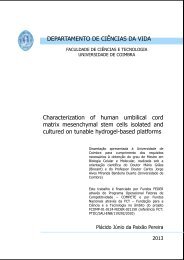Regulation of Apoptosis and Differentiation by p53 in Human ...
Regulation of Apoptosis and Differentiation by p53 in Human ...
Regulation of Apoptosis and Differentiation by p53 in Human ...
Create successful ePaper yourself
Turn your PDF publications into a flip-book with our unique Google optimized e-Paper software.
CHAPTER 1: Introduction<br />
Mitochondrion<br />
Death receptor<br />
Bad<br />
Bax<br />
Bid<br />
Adaptor<br />
Cyt-c<br />
Bcl2<br />
Bid<br />
Casp-8<br />
10<br />
PUMA<br />
Cyt-c<br />
Casp-9<br />
Apaf-1<br />
DNA<br />
damage<br />
Apoptosome<br />
Casp-3<br />
<strong>p53</strong><br />
Post-translational<br />
modifications<br />
Bax<br />
Puma<br />
Noxa<br />
GADD45<br />
p21<br />
MDM2<br />
Cleavage <strong>of</strong> substrates<br />
Nucleus<br />
APOPTOSIS<br />
p14ARF<br />
FIGURE 1.4- Schematic representation <strong>of</strong> apoptotic pathways controlled <strong>by</strong> <strong>p53</strong>.<br />
DNA damage <strong>and</strong> other stress signals converge on <strong>p53</strong> signal<strong>in</strong>g <strong>by</strong> activation <strong>of</strong> prote<strong>in</strong> k<strong>in</strong>ases<br />
<strong>and</strong>/or acetyltransferases, which phosphorylate or acetylate <strong>p53</strong>, respectively. The <strong>in</strong>activation <strong>of</strong><br />
<strong>p53</strong> <strong>by</strong> Mdm2 is counteracted <strong>by</strong> mechanisms <strong>in</strong>volv<strong>in</strong>g post-translational modification <strong>of</strong> <strong>p53</strong> or<br />
the Mdm2 <strong>in</strong>hibitor ARF. These posttranslational modifications generally result not only <strong>in</strong><br />
stabilization, but also <strong>in</strong> activation <strong>of</strong> <strong>p53</strong> <strong>in</strong> the nucleus, where <strong>p53</strong> <strong>in</strong>teracts with sequencespecific<br />
DNA b<strong>in</strong>d<strong>in</strong>g sites <strong>in</strong> its target gene promoters. Through its activity as a sequencespecific<br />
transcriptional activator, <strong>p53</strong> <strong>in</strong>creases the expression <strong>of</strong> pro-apoptotic Bcl-2 family<br />
prote<strong>in</strong>s. <strong>p53</strong> can also have a direct apoptogenic role on the mitochondria, <strong>in</strong>teract<strong>in</strong>g with Bcl2<br />
family <strong>of</strong> regulators <strong>of</strong> mitochondrial permeability. Released apoptogenic factors facilitate the<br />
activation <strong>of</strong> the effector caspases through the Apaf-1–caspase 9-apoptosome.<br />
<strong>p53</strong> can be activated pharmacologically <strong>by</strong> the topoisomerase II <strong>in</strong>hibitor etoposide. This is an<br />
ant<strong>in</strong>eoplastic drug that has been widely used to <strong>in</strong>duced apoptosis <strong>in</strong> response to DNA damage<br />
(Karp<strong>in</strong>ich et al., 2002). Topoisomerase II is a nuclear enzyme that functions dur<strong>in</strong>g both DNA<br />
replication <strong>and</strong> transcription (H<strong>and</strong>e, 1998). Topoisomerase II prevents "knots" from form<strong>in</strong>g <strong>in</strong><br />
DNA <strong>by</strong> allow<strong>in</strong>g the passage <strong>of</strong> an <strong>in</strong>tact segment <strong>of</strong> the helical DNA through a transient double<br />
str<strong>and</strong> break (Burden <strong>and</strong> Osher<strong>of</strong>f, 1998). Topoisomerase II <strong>in</strong>hibitors such as etoposide<br />
stabilize the complex formed <strong>by</strong> topoisomerase II <strong>and</strong> the 5'-cleaved ends <strong>of</strong> the DNA, thus<br />
form<strong>in</strong>g stable (nonrepairable) prote<strong>in</strong>-l<strong>in</strong>ked DNA double str<strong>and</strong> breaks (Burden <strong>and</strong> Osher<strong>of</strong>f,<br />
1998). Cells are apparently able to recognize such DNA damage <strong>and</strong>, <strong>in</strong> turn, to elim<strong>in</strong>ate the<br />
<strong>in</strong>jured cells <strong>by</strong> apoptosis. This is known to be <strong>p53</strong>-mediated via the mitochondrial death pathway.<br />
- 29 -
















